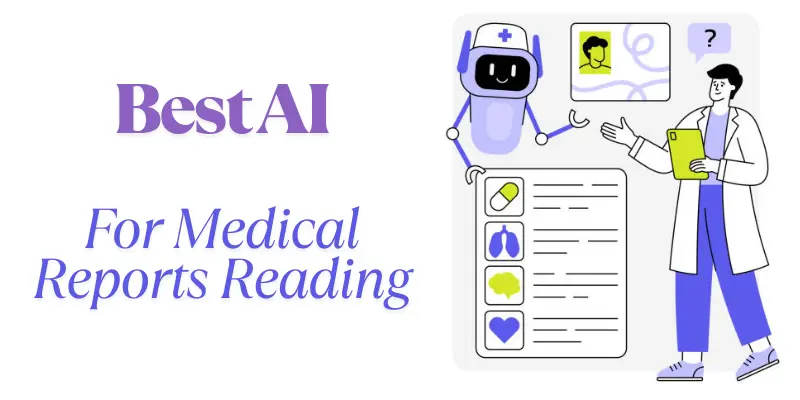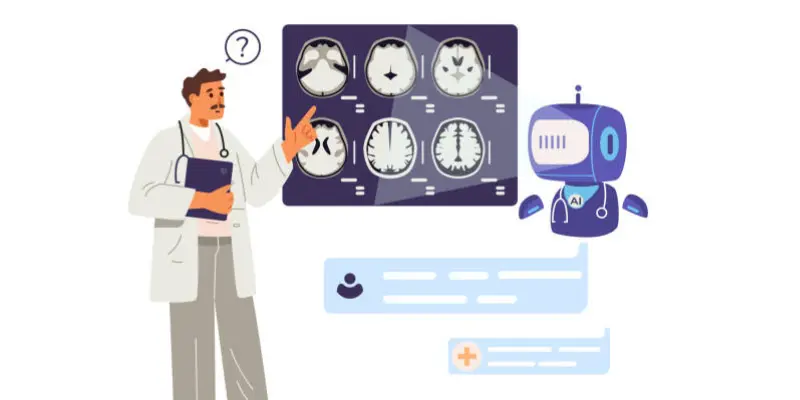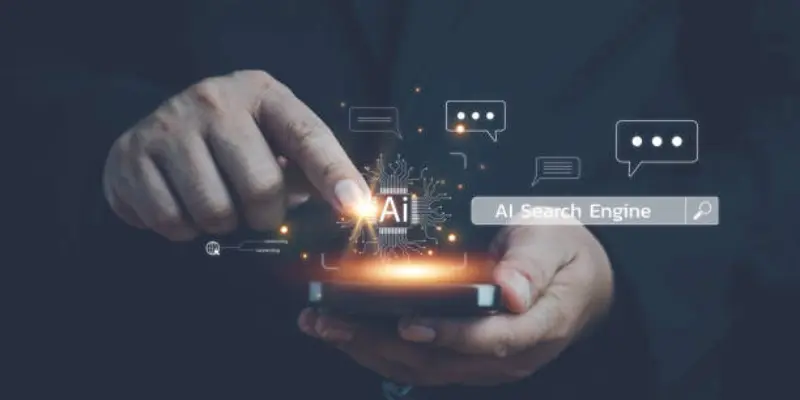Finding The Best AI for Reading Medical Reports
Published: 29 Apr 2025
Medical reports can be long, confusing and full of hard words. Doctors and nurses spend a lot of time reading them. But what if there was an easier way?
Today, smart AI tools are helping healthcare workers to read medical reports faster and more clearly. These tools can find important information in just seconds and save time, lower mistakes and help doctors to take better care of patients.
In this blog, you will learn what AI medical reading is, why it’s important and which is the best AI for medical reports reading. Ready to find out how AI can make reading medical reports easier? Let’s get started!

What Is Medical Report Reading with AI?
Medical report reading with AI means using smart computer programs to understand patient documents. These programs can quickly find important facts like test results or doctor notes, all without getting tired or missing details.
AI reads medical reports almost like a helpful assistant. It looks for keywords, checks for patterns and highlights the most important parts. In this way doctors don’t have to spend hours reading every single line.
Example:
Imagine a busy hospital. A doctor needs to find out if a patient has signs of heart disease. Instead of reading a 30-page report, the doctor uses AI. In just seconds, the AI highlights the parts talking about chest pain, blood pressure and heart test results. The doctor can then make faster and better decisions.
Using AI makes reading medical reports easier, faster and more accurate. Isn’t that a big help for busy healthcare teams?
Why AI Is Changing Medical Report Reading
AI is making a big difference in how doctors and nurses read medical reports. Here’s why:
1. Faster Reading
AI tools can go through hundreds of pages in just a few minutes. This helps doctors find the information they need without wasting time. A doctor in an emergency room uses AI to quickly find a patient’s allergy history before giving medicine.
2. Better Accuracy
AI does not get tired or distracted. It carefully checks every word and number in a report. This helps doctors catch important details they might miss when busy. An AI tool notices a small mistake in a lab report that could have been dangerous if left unseen.
3. More Time for Patients
When doctors spend less time reading reports, they can spend more time talking to and helping their patients. Studies show that clinics using AI tools saw that their doctors had 20% more time for patient visits.
4. Early Detection of Problems
Some AI tools can even spot early signs of diseases by scanning medical reports. This means faster treatment and better results. An AI system catches early signs of lung problems from X-ray reports before symptoms even start.
Top AI Tools for Reading Medical Reports in 2025
Medical report reading can be time-consuming and complex. But with the help of AI, doctors and healthcare professionals can now process reports faster and more accurately. In 2025, AI tools have become smarter, hereby helping healthcare workers spot important information quickly. These AI tools are transforming medical reports by saving time and improving patient care. Let’s explore some of the best AI tools available today for medical report reading.

1. IBM Watson Health
IBM Watson Health is a smart AI platform that reads and understands medical documents. It helps doctors to find important facts hidden inside long reports.
In 2025, Watson Health becomes even faster and better. It now uses advanced language models to understand complex medical terms more easily.
IBM Watson Health saves time for doctors and nurses. It pulls out key information from lab reports, doctor notes and imaging results. Instead of reading everything, doctors can focus only on the most important points. This helps them make quicker and better decisions for their patients.
AI Features That Make It Smart
- Natural Language Processing (NLP): Understands how humans write and talk about health problems.
- Smart Summaries: Creates short, easy to read versions of long reports.
- Clinical Decision Support: Gives helpful suggestions to doctors based on the report findings.
Watson Health is simple to use. Doctors can upload reports or connect Watson directly to hospital systems.
Pros and Cons
Pros:
- Saves time by highlighting important details.
- Reduces mistakes by carefully checking reports.
- Easy to connect with many hospital record systems.
Cons:
- Can be costly for small clinics.
- Needs strong internet and data privacy settings.
Suggested article: Radiology AI Companies in Healthcare
2. DescribeAI
DescribeAI is a smart AI tool made for reading and explaining medical reports. It helps doctors by breaking down complex medical language into simple and clear summaries.
In 2025, DescribeAI has improved with stronger machine learning which makes it even better at handling detailed imaging and pathology reports.
DescribeAI makes medical reports easier to understand for both doctors and patients. Doctors can quickly spot key facts without digging through pages of information. This saves time and helps with faster, more accurate and personalized treatment plans.
AI Features That Make It Smart
- Medical Language Translation: Turns complicated medical words into simple language.
- Highlighting Important Sections: Points out vital details like diagnosis, medications and allergies.
- Custom Summaries: Lets doctors choose what kind of summary they need, such as short notes or full explanations.
DescribeAI is very user-friendly. Doctors can upload reports in just a few clicks. It gives results in neat and easy to read formats.
Pros and Cons
Pros:
- Breaks down hard medical language.
- Works fast with many types of medical documents.
- Helpful for both doctors and patients.
Cons:
- Best results need well-scanned or typed reports.
- Some advanced features may cost extra.
3. ENDEX by Enlitic
ENDEX by Enlitic is an AI tool that focuses on analyzing medical images and reports. It helps doctors to quickly find important information in complex radiology and pathology reports.
By 2025, ENDEX has become even better at detecting early signs of diseases like cancer and heart conditions through medical images and text analysis.
ENDEX improves how doctors read medical reports by focusing on imaging and pathology results. It automatically spots patterns in medical scans and test results which is making it easier for doctors to make faster and more accurate decisions about a patient’s health.
AI Features That Make It Smart
- Image Analysis: Analyzes X-rays, CT scans and MRIs for early signs of diseases.
- Text Integration: Combines image findings with text in reports for a complete diagnosis.
- Advanced Pattern Recognition: Identifies even small changes that could be missed by the human eye.
ENDEX is designed to fit into hospital and clinic systems smoothly. Doctors and medical staff can easily upload images and reports to the platform. The results are shown in a clear format with highlighted findings that need attention.
Pros and Cons
Pros:
- Detects early disease signs through image analysis.
- Speeds up diagnosis by integrating images and text.
- Easy to use with existing hospital systems.
Cons:
- Mainly focused on imaging reports, so it may not work for all types of medical documents.
- Can be expensive for smaller practices.
4. SlidesPilot
SlidesPilot is an AI tool designed to help doctors in reading and creating medical reports faster. It works by analyzing doctor-patient conversations and turning them into structured, accurate reports.
By 2025, SlidesPilot has become more advanced by using speech to text technology to create detailed reports from doctor notes, speech and even presentations.
SlidesPilot helps doctors save time by turning voice notes or recorded conversations into written reports. This allows healthcare professionals to focus more on patient care and less on paperwork. It also ensures that medical reports are accurate and complete, reducing the risk of errors.
AI Features That Make It Smart
- Speech-to-Text: Converts spoken words directly into accurate medical text.
- Smart Report Generation: Automatically structures reports, making them clear and easy to read.
- Real-Time Transcription: Provides instant transcription during doctor-patient conversations.
SlidesPilot is very easy to use. Doctors can simply speak into a microphone or record a conversation. The tool then generates a well-organized report.
What does this mean? Will AI Take Over Medical Coding?
Pros and Cons
Pros:
- Saves time by converting speech into text quickly.
- Makes it easy to generate accurate, detailed reports.
- Reduces paperwork, giving doctors more time for patients.
Cons:
- Best results need clear speech and good audio quality.
- May not work well for all accents or speech patterns.
5. Aidoc
Aidoc is an AI tool that helps radiologists by reading and analyzing medical images like CT scans and MRIs. It spots critical issues such as bleeding or fractures in real-time.
By 2025, Aidoc has become even more advanced by improving its ability to detect early stage conditions and abnormalities in medical imaging, allowing faster interventions.
Aidoc speeds up the process of reading medical images. Radiologists get alerts for any serious findings, so they can act fast. This tool helps doctors catch life-threatening conditions like strokes or internal bleeding earlier, that need immediate attention.
AI Features That Make It Smart
- Real-Time Image Analysis: Detects urgent issues in medical images while the scan is still being reviewed.
- Automated Alerts: Sends instant notifications to doctors when it finds a critical issue.
- Pattern Recognition: Recognizes patterns in medical images to detect early signs of disease.
Aidoc is designed to fit into existing hospital and clinic systems easily. Radiologists can upload CT scans or MRIs and Aidoc’s AI will analyze them in seconds.
Pros and Cons
Pros:
- Detects urgent issues quickly, allowing for fast action.
- Improves accuracy by spotting problems that might be missed by the human eye.
- Integrates well with hospital systems for smooth use.
Cons:
- Primarily focused on imaging, so it may not handle other types of medical reports.
- Requires high-quality images to work accurately.
How to Choose the Right AI Tool for Your Needs
Choosing the right AI tool for reading medical reports is important for improving your practice. With so many options available, it can be tricky to know which one will work best for you.

Here are some simple steps to guide you in making the right choice:
1. Understand Your Needs
Think about what you need the AI tool to do. Are you mainly reading imaging reports or do you also need help with text based reports like doctor’s notes? Some tools are better for analyzing images, while others excel at working with written reports.
2. Consider Ease of Use
Make sure the AI tool is easy for you and your team to use. Looking for those tools that are user-friendly and require little training can help you save time and avoid confusion.
3. Look for Speed and Accuracy
The best AI tools should process reports quickly while maintaining the accuracy. Speed is important for urgent medical cases, while accuracy is key to avoid missing critical information.
4. Check Integration with Existing Systems
Choose a tool that works well with your current healthcare systems. AI tools that can be easily integrated into your electronic health records (EHR) system will save you time and reduce errors.
5. Evaluate Cost and Support
Lastly, consider your budget and the support available. Some AI tools might be expensive but if they improve efficiency and accuracy, they could be worth the investment. Make sure there is a good support system in case you need help using the tool.
Conclusion
So guys! In this article, we discussed ‘Best AI for Reading Medical Reports‘ in detail. These AI tools are transforming how medical professionals handle reports by making the process faster and more accurate. Based on the features and benefits shared, I recommend considering DescribeAI if you need a user-friendly and efficient tool for reading medical texts or Aidoc for a more specialized focus on medical imaging. Remember, choosing the right tool depends on your specific needs and practice type. Ready to take the next step? Explore these AI tools and see how they can improve your workflow today!
Related Queries
Here are frequently asked questions about Best AI in Reading Medical Reports:
No, AI tools are designed to assist healthcare professionals and not replace them. They help by saving time on routine tasks and highlighting important information but doctors still make the final decisions based on their expertise and clinical judgment.
Most advanced AI tools have high accuracy rates but can still make mistakes. They work best when paired with human oversight to catch any errors or unusual cases that AI might miss. The combination of AI assistance and human expertise typically produces the best results.
Most modern medical AI tools are designed to be user-friendly and require minimal training. Staff typically need only a brief orientation session to learn the basic functions, though deeper training might be needed to utilize advanced features.
Reputable medical AI systems are built with strong security measures and compliance with healthcare privacy regulations like HIPAA as a priority. Before implementing any AI tool, healthcare organizations should verify the vendor’s security protocols and compliance certifications.
AI tools are meant to assist rather than replace human judgment, so doctors should always review the AI’s findings. Most systems clearly indicate their confidence levels in findings and healthcare organizations typically have protocols for handling AI-assisted diagnoses.
Costs vary widely based on the tool’s capabilities from a few hundred dollars per month for basic solutions to tens of thousands for enterprise level systems. Many vendors offer tiered pricing models based on usage volume, with some providing discounts for smaller practices or academic institutions.
Most current AI tools work best with digital text and images, though some advanced systems can process clear handwriting with reasonable accuracy. The accuracy for handwritten notes is generally lower than for digital text, so many practices digitize handwritten notes before processing.
Leading medical AI systems now support multiple languages with the most common being English, Spanish, French, German and Chinese. Support quality may vary by language with some tools offering real-time translation features to convert reports into the doctor’s preferred language.
Using AI as a supplementary tool while maintaining professional judgment and oversight shouldn’t increase liability. It’s important to document how AI tools are used in decision-making processes and maintain awareness that the healthcare provider, not the AI, is responsible for patient care decisions.
Many AI vendors now offer scaled-down versions or subscription models specifically designed for smaller practices. Some tools also provide pay per use options and regional healthcare networks sometimes negotiate group discounts for independent practices.





